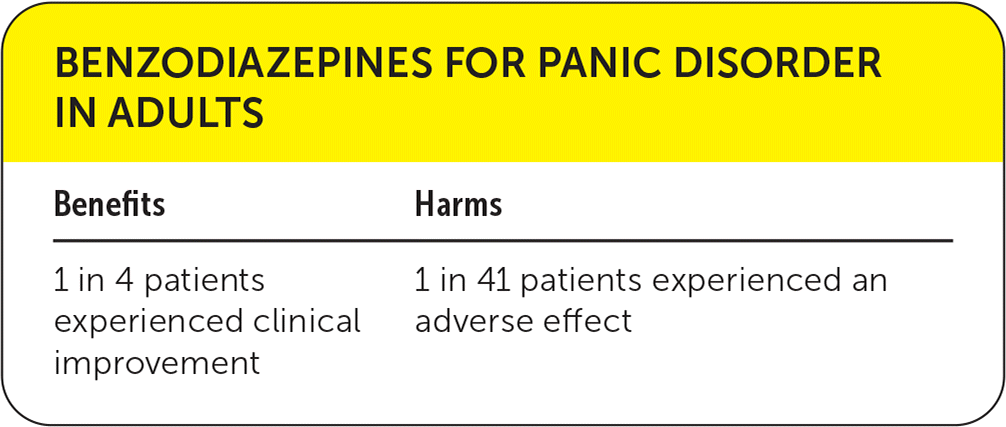
Am Fam Physician. 2020;101(7):online
Author disclosure: No relevant financial affiliations.

Details for This Review
Study Population: Adults with panic disorder, with or without agoraphobia
Efficacy End Points: Clinical response to treatment, remission, panic symptoms, frequency of panic attacks, anxiety, depression
Harm End Points: Treatment acceptability (using dropout rate as a proxy), adverse effects
Narrative: The treatment of panic disorder includes psychological and pharmacologic interventions. Selective serotonin reuptake inhibitors (SSRIs) are the first-line treatment because of a lower adverse effect profile than monoamine oxidase inhibitors and tricyclic antidepressants and a lower incidence of dependence and withdrawal than benzodiazepines. Benzodiazepines continue to be prescribed during the initiation phase of SSRIs for acute relief of panic attacks.

| Benefits | Harms |
|---|---|
| 1 in 4 patients experienced clinical improvement | 1 in 41 patients experienced an adverse effect |
A Cochrane review included 24 double-blind studies that lasted three to 15 weeks.1 The studies involved 4,233 randomized participants (2,124 received benzodiazepines; 1,475 received placebo; and 634 received paroxetine [Paxil], buspirone [Buspar], propranolol, or behavior change therapy). The certainty of evidence was low for all end points.
The primary end points were response to treatment and treatment acceptability, using dropout rate as a proxy. This review found greater response in the benzodiazepine group compared with placebo, with a number needed to treat (NNT) of 4 (95% CI, 3 to 7). Fewer participants dropped out from the benzodiazepine treatment group, with an NNT of 6 (95% CI, 5 to 9) for treatment acceptability.
There were nine secondary end points, including remission, panic symptoms, frequency of panic attacks, agoraphobia, general anxiety, depression, social functioning, number of dropouts due to adverse effects, and number of participants experiencing at least one adverse effect. All secondary outcome analyses demonstrated improvement with benzodiazepines compared with placebo, with the exception of depression symptom score changes and social functioning, which showed no difference. Analysis of adverse effects demonstrated a higher proportion with benzodiazepines, with a number needed to harm of 41 (relative risk = 1.18; 95% CI, 1.02 to 1.37 number of adverse effects).
Caveats: Although 1,744 articles fulfilled initial inclusion criteria, only 24 studies were used for the meta-analysis after evaluation for potential bias. Despite a total of 4,233 participants, there was insufficient information to assess secondary end points of quality of life, patient satisfaction with treatment, and economic cost.
Study bias was a significant factor in the exclusion of multiple studies, largely because of unclear risk of selection and detection bias, with a high risk of bias observed for attrition and reporting. Attrition bias was particularly noteworthy in the unequal dropout rates between treatment and placebo groups, with a much higher dropout rate observed for patients randomized to placebo.
Although heterogeneity was assessed and well accounted for in the analysis, there was variability in the control arm treatments. The control groups included treatment options no longer in widespread use; few studies utilized pharmacotherapy options that are now widely available but may not have been at the time the initial study was conducted.
Lastly, these studies were of short duration, which limits their relevance in applying outcomes to making decisions about first-line therapy. Assessment of the risk of dependency and withdrawal cannot be made from the studies included in this review. The authors acknowledge the risk of dependency and withdrawal and support the current recommendations to avoid the use of benzodiazepines as first-line treatment.2
